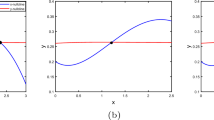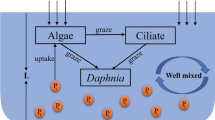Abstract
We investigate a system of two species exploiting a common resource. We consider both abiotic (i.e. with a constant resource supply rate) and biotic (i.e. with resource reproduction and self-limitation) resources. We are interested in the asymmetric competition where a given consumer is the locally superior resource exploiter (LSE) and the other is the locally inferior resource exploiter (LIE). They also interact directly via interference competition in the sense that LIE individuals can use two opposite strategies to compete with LSE individuals: we assume, in the first case, that LIE uses an avoiding strategy, i.e. LIE individuals go to a non-competition patch to avoids competition with LSE individuals, and in the second one, LIE uses an aggressive strategy, i.e. being very aggressive so that LSE individuals have to go to a non-competition patch. We further assume that there is no resource in the non-competition patch so that individuals have to come back to the competition patch for their maintenance, and the migration process acts on a fast time scale in comparison with demography and competition processes. The models show that being aggressive is efficient for LIE’s survival and even provoke global extinction of the LSE and this result does not depend on the nature of resource.






Similar content being viewed by others
References
Amarasekare P (2002) Interference competition and species coexistence. Proc R Soc Lond B 269:25412550
Amarasekare P, Nisbet RM (2001) Spatial heterogeneity, source-sink dynamics, and the local coexistence of competing species. Am Nat 158:572–584
Arditi R, Lobry C, Sari T (2015) Is dispersal always beneficial to carrying capacity? New insights from the multi-patch logistic equation? Theor Popul Biol 106:45–59
Armstrong RA, McGehee R (1980) Competitive exclusion. Am Nat 115:151–170
Auger P, de la Parra RB, Morand S, Sanchez E (2002) A predator-prey model with predators using Hawk and Dove tactics. Math Biosci 177(178):185–200
Auger P, de la Parra RB, Poggicale JC, Sanchez E, Nguyen-Huu T (2008a) Aggregation of variables and applications to population dynamics. In: Magal P, Ruan S (eds) Structured population models in biology and epidemiology, lecture notes in mathematics, mathematical biosciences subseries, vol 1936. Springer, Berlin, pp 209–263
Auger P, de la Parra RB, Poggiale JC, Sanchez E, Sanz L (2008b) Aggregation methods in dynamical systems variables and applications in population and community dynamics. Phys Life Rev 5:79–105
Case TJ, Gilpin ME (1974) Interference competition and niche theory. Proc Natl Acad Sci USA 71:3073–3077
Castella F, Madec S, Lagadeuc Y (2016) Global behavior of N competing species with strong diffusion: diffusion leads to exclusion. Appl Anal 95(2):341–372
Garca-Ramos G, Kirkpatrick M (1997) Genetic models of adaptation and gene flow in peripheral populations. Evolution 51:21–28
Grimm V, Railsback SF (2005) Individual-based modeling and ecology. Princeton University Press, Princeton
Kuznetsov YA (1998) Elements of applied bifurcation theory, 2nd edn. Springer, Berlin
LaSalle JP (1976) The stability of dynamical systems, Regional Conference Series in Applied Matheamtics, SIAM (Philadelphia)
Levin SA, Pimentel D (1981) Selection of intermediate rates of increase in parasitehost systems. Am Nat 117:308–315
Levins R, Culver D (1971) Regional coexistence of species and competition between rare species. Proc Natl Acad Sci USA 68:1246–1248
Liberg O (1981) Predation and social behaviour in a population of domestic cats: an evolutionary perspective. Ph.D. thesis, University of Lund
Lotka AJ (1932) The growth of mixed populations: two species competing for a common food supply. J Wash Acad Sci 22:461–469
Lott DF (1991) Intraspecific variation in the social systems of wild vertebrates. Cambridge University, New York
MacArthur RH, Levins R (1964) Competition, habitat selection, and character displacement in a patchy environment. Proc Natl Acad Sci USA 51:1207–1210
Marva M, Moussaoui A, de la Parra RB, Auger P (2012) A density dependent model describing age-structured population dynamics using Hawk–Dove tactics. J Differ Equ Appl 19(6):1022–1034
Marva M, de la Parra RB, Poggiale JC (2012) Reduction of slow–fast periodic systems: fast migrations in a predator-prey community. Math Models Methods Appl Sci 12:10
Morozov AY, Arashkevich EG (2010) Toward a correct description of zooplankton feeding in models: taking into account food-mediated unsynchronized vertical migration. J Theor Biol 262:346–360
Morozov AYU, Arashkevich EG, Nikishina A, Solovyev K (2011) Nutrient-rich plankton communities stabilized via predatorprey interactions: revisiting the role of vertical heterogeneity. Math Med Biol 28(2):185–215
Moussaoui A, Nguyen Ngoc D, Auger P (2015) Analysis of a model describing stage-structured population dynamics using Hawk–Dove tactics. ARIMA 20:127–143
Nguyen Ngoc D, de la Parra RB, Zavala MA, Auger P (2010) Competition and species coexistence in a metapopulation model: can fast dispersal reverse the outcome of competition? J Theor Biol 266:256–263
Nguyen-Ngoc D, Nguyen-Huu T, Auger P (2012a) Effects of refuges and density dependent dispersal on interspecific competition dynamics. Int J Bifurc Chaos 22(2):1250029
Nguyen-Ngoc D, Nguyen-Huu T, Auger P (2012b) Effects of fast density dependent dispersal on pre-emptive competition dynamics. Ecol Complex 10:26–33
Polis GA, Myers CA, Holt RD (1989) The ecology and evolution of intraguild predation: potential competitors that eat each other. Annu Rev Ecol Syst 20:297–330
Pontier D, Rioux N, Heizmann A (1995) Evidence of selection on the orange allele in the domestic cat Felis catus: the role of social- structure. Oikos 73(3):299–308
Tilman D (1982) Resource competition and community structure. Princeton University Press, Princeton
Vance RR (1984) Interference competition and the coexistence of two competitors on a single limiting resource. Ecology 65:1349–1357
Verhulst F (2007) Singular perturbation methods for slow–fast dynamics. Nonlinear Dyn 50(4):747–753
Acknowledgments
This work was completed while the first author was staying at Vietnam Institute for Advanced Study in Mathematics (VIASM). The author would like to thank the institute for the support. This work was also supported by Vietnamese National Foundation for Science and Technology Development (NAFOSTED) under Grant 101.02-2013.18.
Author information
Authors and Affiliations
Corresponding author
Appendices
Appendix 1: Aggregation Method
Aggregation of variables methods was well performed in Auger et al. (2008a, b). Let us briefly describe the approximate aggregation procedure (see also in Marva et al. 2012). The considered models belong to a class of autonomous system of ordinary differential equations with two time scales can be expressed in the following form:
with \(n\in \mathbb {R}^m\), where maps f and s represent the fast and slow dynamics, respectively, and \(\varepsilon\) is the small positive parameter measuring the time scales ratio when it is possible. To perform its approximate aggregation, system (13) is firstly converted into slow–fast form by means of an appropriate change of variables \(n\in \mathbb {R}^m \rightarrow (x,y) \in \mathbb {R}^{m-k}\times \mathbb {R}^k:\)
where x represents the fast variable and y the slow variables. Finding the transformation \(n \rightarrow (x,y)\) which yields the slow–fast form (14) of the system (13) could be a difficult task and the construction of general algorithms solving this problem is presently an active research line. On the other hand, in some applications for example in Auger et al. (2008a, b), Nguyen Ngoc et al. (2010), Nguyen-Ngoc et al. (2012), Nguyen-Ngoc et al. (2012) the context gives a natural way to define the so-called global variables y and thus to express the system (13) in a slow–fast form. The aggregation method now consists in different steps:
-
Step 1 Taking \(\varepsilon =0\) in the first equation of slow–fast form (14), i.e. \(dx/d\tau =F(x,y)\). For constant y, finding asymptotically stable equilibrium \(x^*(y)\) of this system.
-
Step 2 Substituting \(x^*(y)\) into the second equation of slow–fast form (14), obtaining the aggregated system:
$$\begin{aligned} \dfrac{dy}{dt}=G(x^*(y),y), \end{aligned}$$(15)where \(t=\varepsilon \tau\) represents the slow time variable.
-
Step 3 Checking the two conditions: (H1) the system 15 is structurally stable and (H2) \(\varepsilon\) is small enough, which ensures that the asymptotic behavior of the system (14) can be studied through the system (15).
The mathematical definition of the structural stability can be found in Kuznetsov (1998). The relationship between the asymptotic behaviors of the two systems is just an application of the classical Tikhonov theorem. This theorem and its applications were reviewed in Verhulst (2007).
Appendix 2: Equilibria and Local Stability Analysis of Model 2
1.1 Aggregated Model
1.2 Jacobian Matrix
1.3 Equilibria and Stability
-
At (0, 0, 0) (in the biotic resource case):
$$\begin{aligned} J(0,0,0) = \begin{pmatrix} r &{} 0 &{} 0\\ 0 &{} - \dfrac{d_{1C}m+d_{1N}\beta _0}{L(0)} &{} 0\\ 0 &{} 0 &{} -(d_2+l) \end{pmatrix}. \end{aligned}$$(19)The matrix has one positive eigenvalue r thus (0, 0, 0) is always unstable.
-
At \((R^*,0,0)\):
$$\begin{aligned} J(R^*,0,0) = \begin{pmatrix} -r &{} x'_{C_1} &{} x'_{C_2}\\ 0 &{} \dfrac{-(d_{1C}m+d_{1N}\beta _0)+a_1e_1mR^*}{L(0)}&{} 0\\ 0 &{} 0 &{} -(d_2+l)+a_2e_2R^* \end{pmatrix}. \end{aligned}$$The matrix has three eigenvalues: \(\lambda _1=-r <0\), \(\lambda _2=-(d_{1C}m+d_{1N}\beta _0)+a_1e_1mK\) and \(\lambda _3=-(d_2+l)+a_2e_2K\). Hence, \((R^*,0,0)\) is stable if and only if \(R^*<\text {min}\left\{ R_1^*, R_2^*\right\}\) where
$$\begin{aligned} R_1^*:=\dfrac{d_{1C}m+d_{1N}\beta _0}{a_1e_1m} \,\, \text {and}\,\, R_2^*:= \dfrac{d_2+l}{a_2e_2} \end{aligned}$$ -
At \((R_{1}^{*}, C_{1}^{*}, 0)\) where \(C_1^*=\gamma (R_1^*)L(0)/a_1mR_1^*\): the condition for which this equilibrium is non-negative is given by \(R_1^* < R^*\). In this case, the Jacobian matrix reads as follows:
$$\begin{aligned} J(R_{1}^{*}, C_{1}^{*},0) = \begin{pmatrix} -r\theta (R_1^*) &{} -\dfrac{a_1mR_{1}^{*}}{L(0)} &{} -R_1^*a_2\\ \dfrac{a_1e_1mC_{1}^{*}}{L(0)} &{} 0 &{} -\dfrac{d_{1N}\beta C_1^*}{L(0)}\\ 0 &{} 0 &{} -(d_2+l) + a_2e_2R_1^* \end{pmatrix} \end{aligned}$$where \(\theta (R)=R/K\) in the biotic resource case, and \(\theta (R)=S/R\) in the abiotic resource case. The matrix has one eigenvalue
$$\begin{aligned} \lambda _1= -(d_2+l) + a_2e_2R_1^* \end{aligned}$$and the others eigenvalues, \(\lambda _2, \lambda _3\), are the solutions of the following equation:
$$\begin{aligned} \lambda ^{2} + r\theta (R_{1}^{*})\lambda + \dfrac{a_1^{2}m^2e_1C_{1}^{*}R_{1}^{*}}{L(0)^2} = 0. \end{aligned}$$Since \(\lambda _{2} + \lambda _{3} =-r\theta (R_1^*)< 0\) and \(\lambda _{2}\lambda _{3}=a_1^{2}m^2e_1C_{1}^{*}R_{1}^{*}/L(0)^2 > 0\). Hence, these eigenvalues have negative real parts. Therefore, \((R_{1}^{*},C_{1}^{*},0)\) is stable provided
$$\begin{aligned} -(d_2+l) + a_2e_2R_1^*<0 \Leftrightarrow R_1^* < R_2^*. \end{aligned}$$To summarize, \((R_{1}^{*},C_{1}^{*},0)\) is non-negative and stable provided
$$\begin{aligned} R_1^* \,<\, \text {min} \left\{ R^*, R_2^*\right\} . \end{aligned}$$ -
At \((R_{2}^{*}, 0, C_{2}^{*})\) where \(C_2^*=\gamma (R_2^*)/a_2R_2^*\): the condition for which this equilibrium is non-negative is given by \(R_2^*\,<\,R^*\). In this case, the Jacobian matrix reads as follows:
$$\begin{aligned} J(R_{2}^{*},0, C_{2}^{*}) = \begin{pmatrix} -r\theta (R_2^*) &{} -\dfrac{a_1 m R_{2}^{*}}{L(C_2^*)} &{} -R_{2}^*a_2\\ 0 &{} \dfrac{-(d_{1C}m + d_{1N}\beta _{0}) - d_{1N}\beta C_{2}^* + a_1e_1mR_2^*}{L(C_2^*)}&{} 0\\ C_2^*a_2e_2 &{} 0 &{} 0 \end{pmatrix}. \end{aligned}$$The matrix has one eigenvalue
$$\begin{aligned} \lambda _1= \dfrac{-(d_{1C}m + d_{1N}\beta _{0}) - d_{1N}\beta C_{2}^* + a_1e_1mR_2^*}{L(C_2^*)} \end{aligned}$$and the others eigenvalues, \(\lambda _2, \lambda _3\), are the solutions of the following equation:
$$\begin{aligned} \lambda ^{2} + r\theta (R_2^*)\lambda + a_2^{2}e_2C_{2}^{*}R_{2}^{*} = 0. \end{aligned}$$Since \(\lambda _{2} + \lambda _{3} =-r\theta (R_2^*)< 0\) and \(\lambda _{2}\lambda _{3}=a_2^{2}e_2C_{2}^{*}R_{2}^{*} > 0\). Hence, these eigenvalues have negative real parts. Therefore, \((R_{2}^{*},0, C_{2}^{*})\) is stable provided
$$\begin{aligned}&\dfrac{-(d_{1C}m + d_{1N}\beta _{0}) - d_{1N}\beta C_{2}^* + a_1e_1mR_2^*}{L(C_2^*)}< 0\\&\quad \Leftrightarrow R_2^* < R_1^*+ \dfrac{d_{1N}\beta C_2^*}{a_1e_1m}=R_1^*+\dfrac{d_{1N}\beta }{a_1e_1m}.\dfrac{\gamma (R_2^*)}{a_2R_2^*}. \end{aligned}$$To summarize, \((R_{2}^{*},0, C_{2}^{*})\) is non-negative and stable provided
$$\begin{aligned} R_2^* < \text {min} \left\{ R^*, R_1^*+\dfrac{d_{1N}\beta }{a_1e_1m}.\dfrac{\gamma (R_2^*)}{a_2R_2^*}\right\} . \end{aligned}$$ -
At \((\hat{R}, \hat{C_1}, \hat{C_{2}})\) where \(\hat{R}=R_2^*, \hat{C_1}=(\gamma (\hat{R})-a_2\hat{R}\hat{C_2})L(\hat{C_2})/a_1m\hat{R}, \hat{C_2}=a_1e_1m(R_2^* - R_1^*)/d_{1N}\beta\): the condition for which this equilibrium is non-negative is given by \(R_2^* > R_1^*\) and \(\gamma (\hat{R})-a_2\hat{R}\hat{C_2} > 0\). The second condition means that
$$\begin{aligned} \gamma (R_2^*)-a_2R_2^*\dfrac{a_1e_1m(R_2^*-R_1^*)}{d_{1N}\beta } \end{aligned}$$or else
$$\begin{aligned} R_2^* \,<\, R_1^*+ \dfrac{d_{1N}\beta }{a_1e_1m}.\dfrac{\gamma (R_2^*)}{a_2R_2^*}. \end{aligned}$$In this case, the jacobian matrix reads as follows:
$$\begin{aligned} J(\hat{R},\hat{C_1}, \hat{C_2}) = \begin{pmatrix} -r\theta {\hat{R}} &{} -\dfrac{am}{L(\hat{C_2})}\hat{R} &{} \left( \dfrac{am\hat{C_1}\beta }{(L(\hat{C_2})^2} -b \right) \hat{R}\\ \dfrac{aem \hat{C_1}}{L(\hat{C_2})} &{}0&{} -\dfrac{d_{1N}\beta \hat{C_1}}{L(\hat{C_2})}\\ bf\hat{C_2}&{} 0 &{} 0 \end{pmatrix}. \end{aligned}$$The characteristic equation for the jacobian matrix \(J(\hat{R},\hat{C_1}, \hat{C_2})\) is
$$\begin{aligned} \lambda ^3 + A_1 \lambda ^2 + A_2 \lambda + A_3=0, \end{aligned}$$where
$$\begin{aligned} A_1= & \, r\theta {\hat{R}},\\ A_2= & {} -\dfrac{a_1m\beta \hat{C_1}\hat{R}-a_1e_1m\hat{C_1}a_1m\hat{R}}{(L(\hat{(}C_2)))^2}+a_2\hat{R}, \\ A_3= & {} -\dfrac{a_2e_2\hat{C_2}a_1md_{1N}\beta \hat{C_1}\hat{R}}{(L(\hat{C_2}))^2} \end{aligned}$$Since \(A_1 > 0\) and \(A_3 < 0\) it implies that there exists at least one solution the equation whose real part is not negative (Routh-Hurwitz criteria). Therefore, \((\hat{R},\hat{C_1}, \hat{C_2})\) is unstable.
Rights and permissions
About this article
Cite this article
Nguyen-Ngoc, D., Nguyen-Phuong, T. Effects of Behavioural Strategy on the Exploitative Competition Dynamics. Acta Biotheor 64, 495–517 (2016). https://doi.org/10.1007/s10441-016-9297-9
Received:
Accepted:
Published:
Issue Date:
DOI: https://doi.org/10.1007/s10441-016-9297-9




